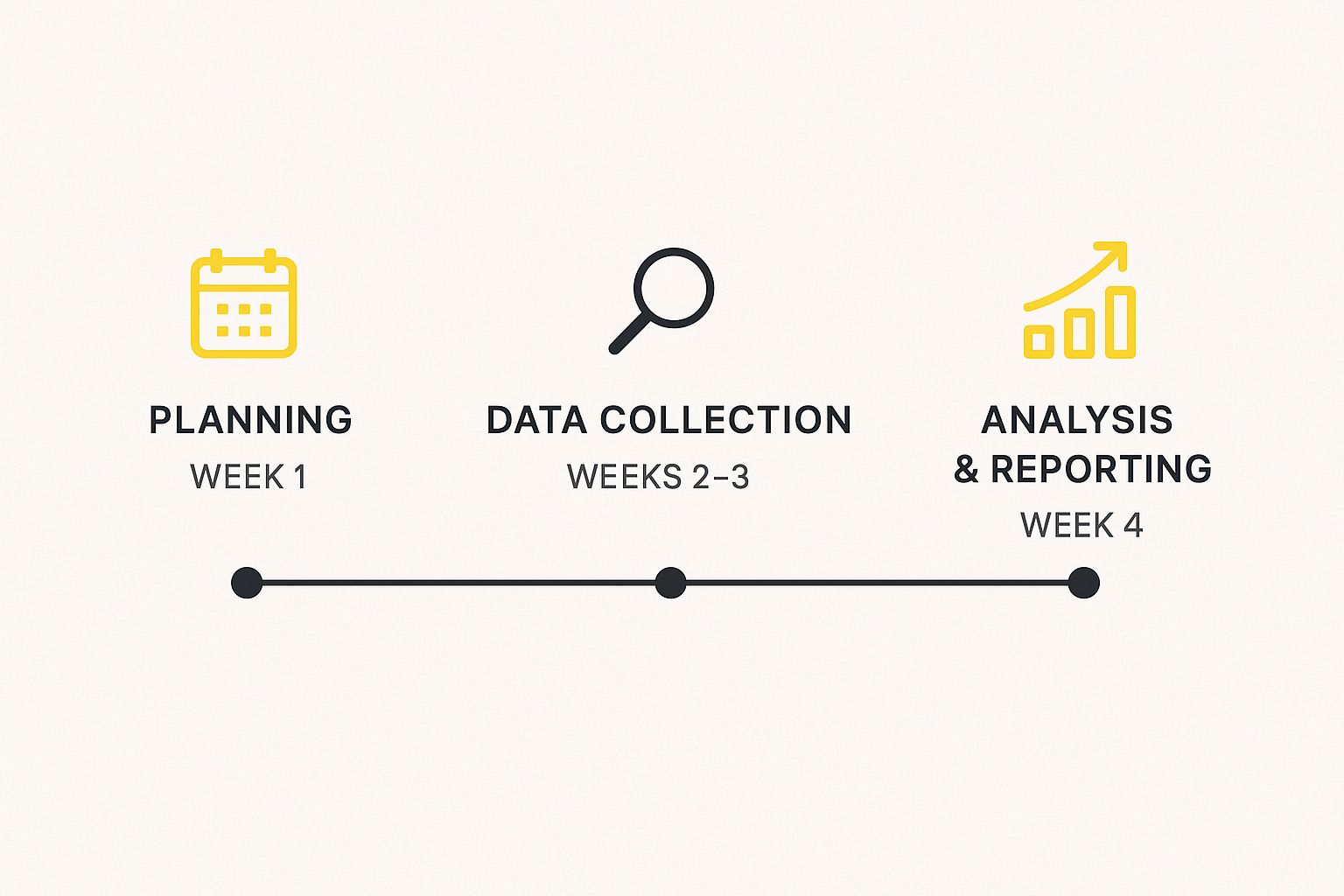Why Your Organization Needs an Internal Communication Audit
Effective internal communication is the backbone of any successful organization. In today's fast-paced business world, a communication breakdown can have serious consequences, leading to decreased productivity, project delays, and a disengaged workforce. An internal communication audit offers a systematic way to evaluate your organization's communication landscape, revealing hidden inefficiencies that impact your bottom line. It's not just about sending emails—it's about ensuring messages are received, understood, and acted upon.
This involves understanding how information flows within your organization, identifying roadblocks, and fostering a culture of clear, consistent communication.
Identifying Communication Breakdowns
An internal communication audit acts as a diagnostic tool, pinpointing the root causes of communication issues. Are your current channels, like email or your intranet, reaching the right people? Are your messages clear, concise, and relevant? The audit can uncover these issues and more.
An audit can also highlight areas where information overload hinders productivity or where a lack of communication creates confusion and uncertainty. This deep dive into your communication practices allows you to address specific challenges with targeted solutions.
The Cost of Poor Communication
Poor internal communication can have significant financial consequences. Wasted time, duplicated efforts, and missed deadlines all contribute to lost revenue. A disengaged workforce can lead to increased staff turnover and difficulty attracting talent.
In the Australian public sector, internal communication plays a crucial role in organizational productivity. Analyses attribute over 100% of the 0.7% annual decline in labor productivity since 2020 to issues linked to government communication practices. This surprising statistic highlights the significant impact of poor internal communication on workforce efficiency. For more detailed statistics, check out this resource: The Future of Internal Communication in the Australian Public Sector. Investing in an internal communication audit can help identify and address these issues, leading to increased efficiency and cost savings.
Benefits of an Internal Communication Audit Template
Using an internal communication audit template can streamline the audit process. A well-designed template provides a structured framework for gathering data, ensuring you cover all essential aspects of your communication ecosystem. This structured approach also simplifies comparing results over time, allowing you to track the effectiveness of your communication strategies.
A comprehensive audit, guided by a practical template, can improve information flow, boost employee engagement, and create a more connected and productive organization. It's an investment in a more effective and collaborative workplace.
Essential Components of a High-Impact Audit Template

A robust internal communication audit template is more than a simple checklist. It's a crucial tool for understanding how information flows within your organization. It should highlight both the strengths and weaknesses of your current communication ecosystem, pointing toward areas ripe for improvement. This deep dive goes beyond basic surveys, incorporating methods to gather both quantitative and qualitative data, offering a comprehensive picture of your internal communications.
Key Elements of an Effective Template
An effective template needs several key ingredients to truly make a difference. Let's break down these essential elements:
-
Clear Objectives: Before you begin, define exactly what you hope to achieve. Is it improving employee engagement? Perhaps streamlining information flow is the goal. Or maybe you need to assess how new communication tools are performing. Clearly defined objectives will guide your audit process.
-
Target Audience Segmentation: Your organization likely has diverse groups with unique communication needs. Frontline workers, for instance, will have different requirements than office-based staff. Segmenting your audience ensures you gather the most relevant data from each specific group.
-
Multi-Faceted Data Collection: A single method rarely tells the whole story. Combining surveys, interviews, and focus groups paints a more holistic picture of your internal communication landscape. Surveys provide valuable quantitative data, while interviews and focus groups offer richer qualitative insights.
-
Channel Analysis: Evaluate the effectiveness of your communication channels. How well are email, your intranet, and face-to-face meetings serving their purpose? Consider usage rates, feedback from employees, and how well each channel aligns with your overall business objectives.
To understand these elements further, let's explore how they translate into a practical template structure. The following table details the essential components of a successful internal communication audit template.
To get started building your template, consider the following framework:
Essential Components of an Internal Communication Audit Template
| Audit Component | Purpose | Key Questions to Address | Measurement Approaches |
|---|---|---|---|
| Communication Channels | Identify all communication methods used within the organization. | What channels are currently used? How frequently are they used? | Channel usage statistics, employee surveys. |
| Target Audience | Define specific groups within the organization. | Who are the key audiences for each channel? What are their specific communication needs? | Stakeholder analysis, departmental surveys. |
| Key Questions | Develop targeted questions for each audience and channel. | How effective are the current channels in reaching the target audience? Are messages clear and understood? | Surveys with rating scales and open-ended feedback, interviews, focus groups. |
| Measurement | Determine how responses will be measured. | How will quantitative and qualitative data be collected and analyzed? | Statistical analysis of survey data, qualitative analysis of interview and focus group transcripts. |
This table provides a solid foundation for building your internal communications audit template. By addressing these core components, you can gain valuable insights into your organization’s communication effectiveness.
Building Your Template: A Practical Approach
Creating a high-impact template isn't as daunting as it might seem. Begin with a straightforward structure and adapt it to your specific needs.
-
Communication Channels: List every channel currently used within your organization. This includes everything from email and instant messaging platforms like Slack to traditional methods like face-to-face meetings and printed newsletters.
-
Target Audience: Specify the groups you'll be focusing on for each channel. Consider different departments, roles, and locations within your organization.
-
Key Questions: Craft specific questions for each audience and channel. For example, "How often do you use the company intranet?" or "How clear are leadership messages?". These targeted questions will provide valuable data for your analysis.
-
Measurement: Decide how you'll measure responses to each question. This could involve rating scales, open-ended feedback, or a combination of both.
Looking for additional guidance? Reviewing established corporate communication best practices can provide valuable insights. You can also learn more about internal communication tips to kickstart 2025.
Adapting Your Template
Your internal communication audit template should be a living document, regularly reviewed and revised based on your evolving business needs, the adoption of new technologies, and feedback from your employees. This ensures its relevance and continued ability to provide actionable insights. This continuous improvement fosters more effective communication, a stronger organizational culture, and a more engaged workforce. By taking a proactive approach, your audit template remains a valuable tool for positive change within your organization.
Uncovering Hidden Communication Barriers Through Your Audit

Your internal communication audit template is more than a simple form; it's a powerful tool for diagnosing problems. It helps uncover communication barriers that often impact productivity and team morale. Think of it like an X-ray, revealing underlying issues that aren't always obvious. These hidden problems can range from using outdated technology to a lack of trust between management and employees. This section explores how to use your audit template to bring these issues to light.
Creating a Psychologically Safe Environment for Honest Feedback
A successful audit relies on creating a safe environment for employees to provide honest feedback. This means fostering psychological safety, where team members can comfortably express their opinions without fear. Imagine a team meeting where everyone agrees with the manager, even if they privately disagree. This lack of open communication can hide real problems and prevent progress. Creating psychological safety isn't just about asking for feedback; it's about building a culture where honesty is valued. This leads to more accurate data that truly reflects your organization’s communication.
To create this safe environment, consider these steps:
- Anonymous Surveys: Give employees a chance to share thoughts anonymously.
- Confidential Interviews: Assure participants that individual responses will be kept private.
- Focus Groups with Trained Facilitators: Neutral facilitators can guide open discussions and handle sensitive topics.
- Clear Communication about the Audit's Purpose: Explain why the audit is being conducted and how the feedback will be used for improvement.
These steps create a safe space for honest dialogue, leading to a more accurate and insightful audit.
Analyzing Your Audit Findings: From Data to Actionable Insights
After gathering your data, the next step is analysis. This involves finding recurring themes, pinpointing problem areas, and developing solutions. A thorough internal communication audit can reveal some critical barriers. For example, unsuitable technology and communication channels can be a major issue. Overwhelming employees with high volumes of communication is another frequent problem. The 2025 State of the Sector report highlights some key statistics: 24% of respondents cited unsuitable technology and channels, while 19% pointed to high communication volumes. Additionally, 18% reported poor manager communication skills, and 17% noted a lack of clear direction from leadership. You can find more detailed statistics at Communication Statistics. Remember, though, numbers alone don't tell the whole story. Combining quantitative data with qualitative feedback from interviews and focus groups provides a more complete picture.
Prioritizing Interventions and Driving Meaningful Change
With a clear understanding of your communication challenges, you can prioritize interventions and develop a plan. This involves a few key steps:
- Identifying Quick Wins: Focus on small, achievable changes for an immediate impact. For instance, if employees report information overload, try clearer email subject lines and fewer non-essential messages.
- Addressing Systemic Issues: Tackle bigger problems, like ineffective communication channels or poor leadership communication, with long-term strategies. This might involve adopting a new intranet or implementing communication training for managers.
- Tracking Progress and Measuring Impact: Regularly monitor the effectiveness of your interventions and adjust as needed. This ensures your efforts are creating positive change.
By following these strategies, you can turn communication breakdowns into opportunities for growth, creating a more connected and productive work environment.
Implementing Your Audit: A Step-by-Step Implementation Guide

This infographic shows the timeline for implementing an internal communication audit. It's broken down into Planning, Data Collection, and Analysis & Reporting. A well-structured audit can be completed in about a month, with the initial planning taking roughly a week. This efficient approach allows for timely data gathering, analysis, and action planning.
Securing Buy-In and Setting the Stage
Identifying communication barriers is key to a successful internal communication audit. For more information, check out these strategies to improve workplace communication. Before diving into data collection, it's essential to secure leadership buy-in. Clearly explain the audit's purpose and the benefits it will bring to the organization. This fosters collaboration and ensures recommendations are taken seriously, much like getting approval for a new project requires demonstrating its value and alignment with business goals.
Next, define the audit's scope. Will it cover specific departments, communication channels, or the entire organization? A well-defined scope keeps your efforts focused and manageable, making resource allocation and project management much easier.
Gathering Data: A Multi-Faceted Approach
Effective data collection involves multiple methods to get a complete picture of your communication environment. It's like a detective gathering evidence from various sources. Use surveys for quantitative data on communication channel usage and message effectiveness. For instance, a survey might reveal that only 50% of employees find company newsletters informative.
Conduct interviews and focus groups for qualitative data, allowing for deeper exploration of employee experiences. These conversations could uncover why the newsletter isn't working, perhaps due to an outdated format difficult to read on mobile devices.
To encourage participation, ensure confidentiality and anonymity when appropriate. Emphasize that the audit aims to improve communication, not to single out individuals. This creates a safe space for honest feedback, leading to more accurate results.
Analyzing Data and Identifying Key Themes
After collecting data, analyze it for recurring themes and patterns. Look for discrepancies between management's perception of communication and employee experiences. Leadership might believe they communicate effectively about company strategy, while employees report feeling left in the dark.
These gaps highlight areas for improvement. Prioritize findings based on their potential impact and how easily they can be implemented. Focus on tackling the most critical communication barriers first.
Developing an Action Plan and Communicating Results
Turn your insights into an actionable communication plan. This plan should address the identified challenges with specific objectives, timelines, and responsibilities. To improve newsletter readership, for example, the plan might involve redesigning the format for mobile devices and creating more relevant content.
Share the audit's findings and the proposed action plan with leadership and employees. Explain how the improvements will benefit the organization and individual teams. This transparency ensures everyone understands the rationale behind the changes.
Before presenting the action plan, let's review the projected implementation timeline:
Internal Communication Audit Implementation Timeline
This table outlines the phases, durations, key activities, expected outcomes, and common challenges associated with implementing the internal communication audit.
| Phase | Duration | Key Activities | Expected Outcomes | Common Challenges |
|---|---|---|---|---|
| Planning & Buy-in | 1 week | Define scope, secure leadership support, develop communication plan | Clear objectives, stakeholder alignment | Resistance to change, lack of resources |
| Data Collection | 1 week | Surveys, interviews, focus groups, document review | Comprehensive data on communication practices | Low survey response rates, difficulty scheduling interviews |
| Analysis & Reporting | 1 week | Data analysis, identify key themes, develop recommendations | Actionable insights, prioritized recommendations | Data interpretation, identifying root causes |
| Action Plan Development | 1 week | Develop specific strategies, assign responsibilities, set timelines | Concrete action plan with measurable goals | Lack of buy-in, difficulty securing resources |
| Implementation & Evaluation | Ongoing | Implement recommendations, monitor progress, gather feedback | Improved communication effectiveness | Difficulty tracking progress, sustaining momentum |
This timeline allows for a structured approach to implementing audit recommendations, ensuring each phase receives adequate attention. Managing potential challenges proactively is crucial for successful implementation.
Ongoing Evaluation and Continuous Improvement
An internal communication audit isn't a one-time event. Regular evaluation is essential to ensure the changes are effective and to identify any emerging challenges. Implementing a feedback mechanism for ongoing employee input ensures your internal communication stays effective and aligns with organizational goals. Think of it like regular car maintenance—it prevents major problems down the road.
Measuring What Matters: Channel Effectiveness and Message Impact

This image shows us the many ways we communicate, reminding us to check if they're working as well as they could be. Just like choosing the right tool for a job, businesses need to pick the best communication channels for their messages. It's about more than just simple metrics like open rates and clicks. A good internal communication audit template looks at the real impact of your communication. It's not just about whether the message was seen, it's about whether it truly resonated with your team.
Evaluating Channel Performance: Beyond Vanity Metrics
Many organizations rely on surface-level metrics like email open rates or intranet page views. These vanity metrics can be misleading. A high open rate doesn't mean a message was understood or acted upon.
For example, imagine an important email about a new company policy. It might have a high open rate, but if employees don't understand the policy, the communication has failed. A strong internal communication audit template digs deeper. It looks at whether each channel is fit-for-purpose.
Are you using email for quick updates when a team messaging platform like Slack might be better? Are crucial announcements lost in a long newsletter? It's about evaluating the strengths and weaknesses of each channel for each specific message.
Consider these points when evaluating channel performance:
- Reach: Is the message getting to everyone it needs to?
- Engagement: Does the channel encourage interaction and feedback?
- Clarity: Does the channel allow for clear and concise communication?
- Timeliness: Is the channel suitable for how urgent the message is?
By considering these factors, you'll choose the right channel for each message, making sure it has the biggest impact.
Measuring Message Resonance: Understanding, Belief, and Action
Effective communication isn't just about delivering a message; it's about ensuring the message is understood, believed, and acted upon. It's about making a real connection, which is key to driving change within an organization.
To gauge how well a message resonates, include these methods in your internal communication audit template:
- Surveys with open-ended questions: Let employees explain their understanding in their own words.
- Focus groups: Give employees a safe space to discuss message clarity and impact.
- Interviews: Explore employee perceptions and beliefs in detail.
By using these approaches, you'll gain valuable insight into how your messages are received and understood.
Segmenting Your Analysis for Targeted Improvements
A thorough internal communication audit pinpoints targeted improvement opportunities, just like a doctor diagnoses specific health issues. This means segmenting your analysis by department, role, location, and other relevant factors.
For instance, frontline workers might prefer face-to-face communication, while remote teams might depend more on digital tools. Recognizing these differences lets you tailor communication for maximum effectiveness.
Analyzing your audit findings by segment also helps identify communication roadblocks specific to certain groups. This focused approach leads to more effective solutions and noticeable improvements in communication. By addressing the needs of different employee segments, your audit helps maximize your communication efforts across the entire organization.
Transforming Insights Into Action: Your Strategic Communication Plan
An internal communication audit template helps identify areas for improvement. But the real work begins after the audit—transforming those insights into a strategic communication plan. This is where many organizations stumble. A brilliant internal communication audit is worthless if it doesn't lead to real change within your Australian workplace. This section explores how to turn your audit findings into a concrete plan that gets results. Think of your audit findings as a diagnosis and your strategic communication plan as the treatment.
Prioritizing Initiatives: Balancing Impact and Feasibility
Not all audit findings are created equal. Some issues will have a bigger impact on your organization than others. Some will be easier to fix than others. You need a system for prioritizing initiatives based on their potential impact and feasibility.
A simple decision matrix can help. List your potential initiatives, then score them based on their potential impact (high, medium, low) and feasibility (high, medium, low). This visual representation helps determine which actions will deliver the most significant improvements with the resources available.
For example, implementing a new company-wide communication platform will have a high impact but also low feasibility due to associated costs. Conversely, training managers on active listening skills is high in feasibility but may only have a medium impact on overall communication. Prioritizing this way ensures that you focus on the most important and achievable improvements first. It's about getting the biggest bang for your buck.
Addressing Specific Communication Barriers
Your internal communication audit will likely uncover a range of specific barriers. These could include:
-
Information Overload: Too many emails, messages, and meetings can overwhelm employees, making it hard to focus on what’s important.
-
Leadership Communication Gaps: A disconnect between leadership’s messages and what employees hear can lead to confusion and mistrust.
-
Channel Ineffectiveness: Using the wrong channels for certain messages can limit their reach and impact. For example, an important announcement buried in a long newsletter may go unnoticed.
-
Lack of Two-Way Communication: Employees need opportunities to share feedback and ask questions. Without these avenues, valuable insights can be lost, and employees can feel unheard.
For each identified barrier, develop specific interventions. These could include:
-
Implementing an Email Management Policy: Encourage the use of clear subject lines, limit "reply all," and establish core communication hours.
-
Improving Leadership Visibility: Encourage leaders to hold regular Q&A sessions and share video updates to make them feel more approachable.
-
Optimizing Channel Usage: Use Slack for team discussions, email for formal announcements, and face-to-face meetings for sensitive topics.
-
Introducing Regular Feedback Mechanisms: Conduct employee pulse surveys, establish feedback channels, and create opportunities for open dialogue.
These targeted interventions, tailored to your specific needs, are key to achieving meaningful improvements.
Establishing Accountability and Tracking Progress
A strategic communication plan needs clear accountability. Assign specific individuals or teams responsibility for implementing each initiative. Just like project management requires assigned roles, defining clear responsibilities ensures that tasks don't fall through the cracks.
Establish measurable goals and track progress regularly. How will you know if your interventions are working? Use metrics like employee survey results, channel usage statistics, and feedback from managers. For example, if you're trying to reduce email overload, track the average number of emails sent and received per day. If you're working to improve leadership communication, measure employee perceptions of leadership visibility and clarity. This data-driven approach ensures you're moving in the right direction.
Maintaining Momentum: Sustaining Long-Term Change
Implementing a strategic communication plan requires more than initial enthusiasm. It requires sustained effort. Regularly review your plan, celebrate successes, and adjust your approach as needed. Think of it like maintaining a healthy lifestyle—it requires ongoing effort. Creating a communication committee can help sustain focus and momentum. This team, representing different parts of the organization, can champion communication improvements and keep the conversation going.
By prioritizing initiatives, developing targeted interventions, and establishing clear accountability, you can turn audit insights into tangible results, creating a more effective communication ecosystem within your organization. This transformed communication strengthens your organizational culture, boosts employee engagement, and ultimately drives business success in the dynamic Australian market.
Building a Culture of Communication Excellence: Beyond the Audit
An internal communication audit template offers a valuable snapshot of your current communication effectiveness. However, real, lasting change requires more than a one-time audit. It demands weaving communication excellence into the very fabric of your organization. This means fostering a culture where effective communication is everyone's shared responsibility, not just a periodic corporate initiative. Think of it like physical fitness: one trip to the gym won't transform you into an athlete. It takes consistent effort and a fundamental lifestyle change.
Establishing Sustainable Assessment Cycles
Leading Australian organizations recognize the vital importance of continuous assessment. They establish sustainable cycles of audits and reviews, ensuring their communication strategies remain effective and adaptable to the ever-changing business landscape. These regular check-ups, much like routine health screenings, help pinpoint and address potential communication issues before they escalate into larger problems. They also provide essential data for tracking progress and showcasing the positive impact of communication initiatives. The frequency of these audits can vary depending on the organization, but an annual or bi-annual review is often a good starting point.
Implementing Lightweight Pulse Checks
Between these more formal audits, lightweight pulse checks offer a convenient way to monitor the health of your communication channels. These quick assessments provide real-time feedback on specific communication issues or initiatives. Think of it like taking your pulse – a quick and easy way to get a read on your current state. For example, a brief survey after a major company announcement can assess employee understanding and highlight any areas needing clarification. These pulse checks keep communication top-of-mind and prevent complacency from setting in.
Maintaining Momentum Amidst Competing Priorities
In today's fast-paced business environment, it's easy for communication initiatives to get lost in the shuffle. Maintaining momentum requires dedicated effort and a strong commitment from leadership. It's about making communication a non-negotiable element of your organizational strategy. One effective strategy is establishing a communication committee responsible for overseeing communication improvements and keeping these important conversations alive. This dedicated team can help integrate effective communication practices into the day-to-day operations of the organization. Another valuable tactic is regularly celebrating communication successes and acknowledging the contributions of individuals and teams.
Learning From Australian Success Stories
Numerous Australian organizations have successfully integrated communication excellence into their culture. They've built robust internal capabilities, implemented accountability systems, and developed metrics that drive continuous improvement. For example, some organizations offer communication skills training to all employees, empowering them to become more effective communicators. Others link communication performance to individual and team objectives, creating a culture of shared accountability. By examining these success stories, other organizations can glean valuable insights and strategies for embedding communication excellence within their own teams.
Building Internal Capabilities and Accountability
Cultivating a culture of communication excellence requires investment in internal capabilities. This means providing employees with the necessary skills and resources to communicate effectively. Training programs focused on active listening, clear writing, and impactful presentation skills can equip individuals with the tools they need to become better communicators. Just like any other professional skill, communication requires ongoing development and refinement. Coupled with capability building, accountability systems ensure improvements are not temporary but become ingrained within the organizational framework.
Developing Metrics That Drive Improvement
Finally, developing the right metrics is crucial for sustaining communication excellence. These metrics should move beyond superficial measures like email open rates and focus on tangible outcomes like employee understanding, engagement, and demonstrable behavior change. For example, tracking employee satisfaction with communication channels or measuring the impact of communication on project success can provide valuable insights. Just as businesses track financial performance, they must also monitor the health of their communication to ensure it's contributing to overall success. This data-driven approach helps showcase the value of communication and justifies ongoing investment.
Ready to transform your communication? OnSilent, a smart voicemail and call management solution, can help you stay on top of your communication and free up valuable time. Learn more about how OnSilent can streamline your communications.

